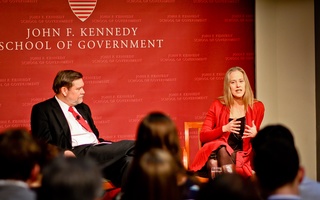Harvard defied a trend of administrative bloat experienced among U.S. private research institutions from 2000 to 2012, which saw on average a 24 percent decrease in the ratio of full time faculty and staff to administrators, a new report by the Delta Cost Project released Wednesday shows.
But while the University saw its own faculty/staff to administrator ratio increase by a little less than 20 percent over the same period, its 2000 figure of 1.57 to one was below the peer average at the time, meaning that despite gains in faculty and staff, Harvard is now on par with peer institutions at a ratio of 1.9 to one.
“[Administrative] growth, for the most part, has been greater at private universities for the past quarter century,” said Benjamin Ginsberg, a political scientist at Johns Hopkins who has written on the topic of administrative growth in higher education. “Some of the very top schools have resisted this, and that’s probably why they continue to be top schools. Harvard is one.”
The increase in Harvard’s proportion of non-administrators to administrators is in part thanks to its growth in faculty. Between 2000 and 2011, Harvard’s non-administrative full time employee count rose by more than 2000. Of those 2000 employees, however, core faculty members accounted for only a little more than 300, according to a cross-comparison of records in several editions of the Harvard University Fact Book. The remaining 1700 positions were added to clerical, technical, service and trades, non-core teaching and research areas, as well as support staff, the Fact Book shows.
Jeff Neal, a spokesperson for the Faculty of Arts and Sciences, wrote in an email that the increase in tenured and tenure-track FAS faculty, from 586 in 2000 to a high of 722 in 2011-2012, was “a deliberate investment by the FAS and Harvard to grow our faculty and strengthen our faculty-to-student ratio, reflecting the priority for more involvement of faculty in teaching as well as research.”
Some staff growth, particularly in FAS, “reflects an effort to respond to undergraduate requests for more support in a host of areas,” Neal also wrote.
Growth in FAS’s employee roster comes in tandem with its curricular growth. In 2007, the University ratified the creation of the School of Engineering of Arts and Sciences under the purview of FAS and committed to its expansion. Previously, SEAS existed only as a faculty division.
A significant increase in its faculty/staff to administrator ratio took place after the financial crisis of 2008-2009 and subsequent administrative cuts. At the beginning of 2008, the ratio of faculty/staff to administrators stood at 1.55 to one, lower than the 2000 figure, the fact book shows.
While Ginsberg said that administrative growth can often lead to an increase in tuition, Harvard students have largely been insulated from these tuition drivers due to the large size of the institution’s endowment and financial aid funds. Since 2007, the year before the global financial crisis, the FAS budget for undergraduate financial aid has increased by more than 80 percent.
Private research universities were the only kind of institution that added full-time professorships—an average of 16 per 1,000 full-time-equivalent students—from 2000 to 2012, the Delta Cost Project report, “Labor Intensive or Labor Expensive? Changing Staffing and Compensation Patterns in Higher Education,”showed.
On average, across all U.S. institutions of higher learning, it found that the faculty/staff to administrator ratio has fallen by 40 percent, to approximately 2.5 to one.
In the report, faculty and staff referred to full-time faculty, part-time faculty, graduate assistants and instructors, whereas administrators entailed executive and managerial positions, such as provosts and deans, as well as support and service professionals, like health workers, human resources, and counselors.
The report argued that new administrative positions, particularly in student services, drove a 28 percent expansion of the public and private nonprofit higher education workforce from 2000 to 2012, a growth rate more than 50 percent faster than in the previous decade.
“It changes the character of education,” Ginsberg said. “For a professor, the purpose of a university is teaching and research.... To an administrator, especially to those who have never been professors, the purpose of teaching and research is to bring customers to the store.”
“Unfortunately,” he added, “more and more administrators have never been professors.”
—Staff writer Amna H. Hashmi can be reached at amnahashmi@college.harvard.edu. Follow her on Twitter @amna_hashmi.
—Staff writer Steven R. Watros can be reached at steven.watros@thecrimson.com. Follow him on Twitter @SteveWatros.
Read more in University News
Architecture Critic Lectures on 'The Politics of Public Space'Recommended Articles
-
On Ratios and Ragersnd can be tough to live down. Your entire entryway can find out your favorite color underwear after just one ...
-
Harvard Fund Helps Community HousingThe new Doña Betsaida Gutiérrez Housing Cooperative that opened in Jamaica Plain on Saturday is the latest project made possible by the Harvard’s 20/20/2000 Housing Initiative.
-
 Cambridge Humbles Harvard on World University Ranking
Cambridge Humbles Harvard on World University Ranking -
Bank Leader of Thailand Talks Economic Confidence, GrowthAs investors continue to voice concerns over market growth in Asia, Governor of the Bank of Thailand Prasarn Trairatvorakul emphasized the importance of strong political institutions in coping with today's economic challenges in a lecture at the Harvard Kennedy School.
-
Raising the RatioLimiting administrative growth in favor of faculty investment enhances the student experience and improves Harvard’s research output.
-
 Kopp Discusses TFA's Recruitment Methods
Kopp Discusses TFA's Recruitment Methods













